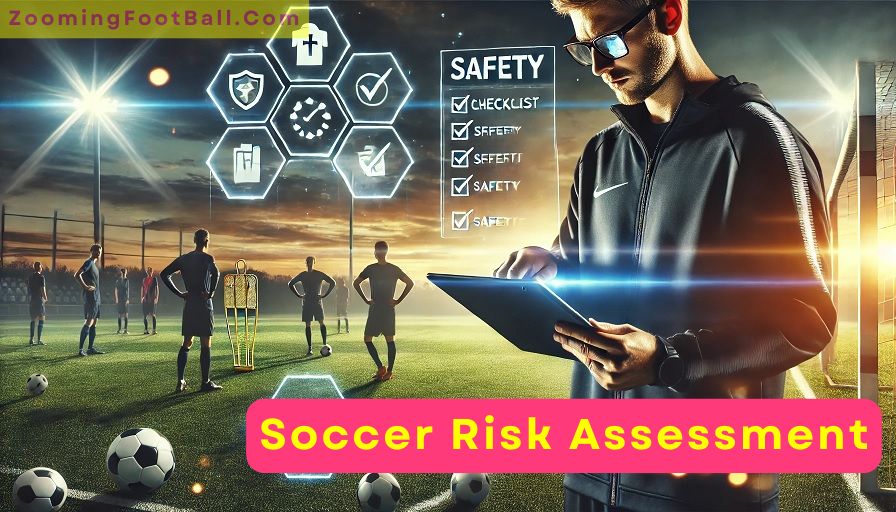Soccer is more than just a game—it’s a passion that brings people together. But with great passion comes great responsibility, especially when it comes to safety. Whether you’re a coach, a club manager, or a parent, understanding risk assessment in Soccer coaching is crucial.
This ultimate guide will walk you through everything you need to know about identifying hazards, preventing injuries, and creating a safe environment for players, coaches, and spectators.
From the Soccer pitch to the clubhouse, every aspect of the game requires careful planning. This guide covers safety measures, emergency procedures, and practical tips to ensure your training sessions and sports events are both fun and secure. Let’s dive in and explore how you can make player safety a top priority.

What is a Risk Assessment in Soccer?
A risk assessment in Soccer is a structured process used to identify potential hazards, evaluate their risks, and implement measures to ensure the safety of everyone involved. This includes players, coaches, spectators, and staff. The goal is to create a safe environment where the game can be enjoyed without unnecessary risks.
For example, a risk assessment might involve checking the condition of the Soccer pitch, ensuring equipment like goalposts are secure, and preparing for weather conditions that could affect play.
By systematically addressing these factors, Soccer clubs can prevent injuries, comply with legal requirements, and focus on player development and skill improvement.|
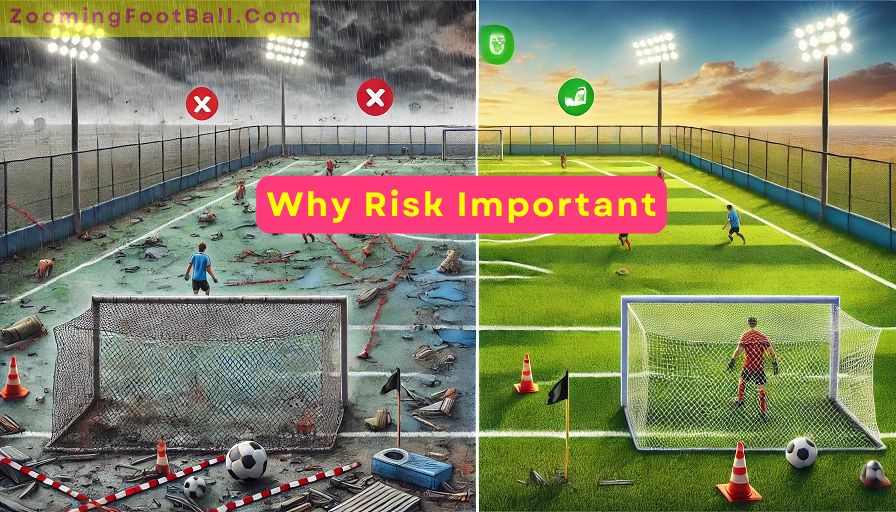
Why is Risk Assessment Important in Soccer Coaching?
1. Ensures Player Safety by Identifying Potential Hazards
The primary goal of a risk assessment is to protect players from harm. Soccer is a physically demanding sport, and hazards like uneven pitches, faulty equipment, or extreme weather conditions can lead to serious injuries.
For instance, a slippery pitch increases the risk of slips and falls, while poorly maintained goalposts can cause accidents during matches or training sessions.
By identifying these risks early, coaches can take steps to mitigate them. This might include rescheduling training during bad weather, repairing damaged equipment, or ensuring protective gear is worn during drills. A proactive approach to safety not only prevents injuries but also builds trust between players and coaches.
2. Reduces Legal Risks by Complying with Safety Regulations
Risk assessments are not just about safety—they’re also a legal requirement. Soccer clubs and coaches have a duty of care to ensure the well-being of everyone involved in the game.
Failure to conduct proper risk assessments can result in legal consequences, especially if an accident occurs due to negligence.
For example, if a player is injured because of an unmarked hazard on the pitch, the club could face lawsuits or penalties. By following guidelines and documenting risk assessments, clubs can demonstrate their commitment to safety and avoid costly legal disputes.
3. Improves Game Performance by Minimizing Preventable Accidents
A safe environment allows players to focus on their skill development and performance. When hazards are minimized, players can train and play with confidence, knowing that their safety is a priority.
For example, ensuring proper hydration and warm-up routines reduces the risk of cramps and muscle strains, allowing players to perform at their best.
Additionally, coaches can dedicate more time to coaching tips and Soccer drills rather than dealing with preventable accidents. This leads to better player development and a more enjoyable experience for everyone involved.
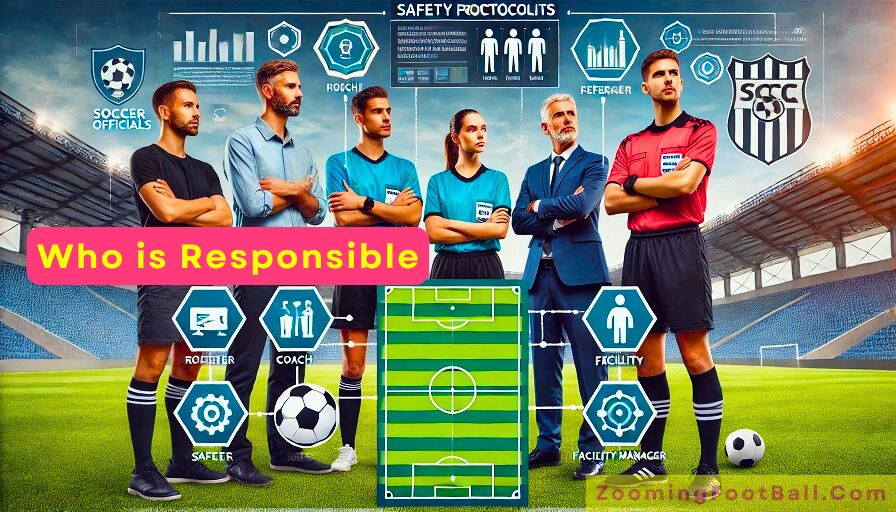
Who is Responsible for Completing Soccer Risk Assessments?
1. Coaches and Assistant Coaches
Coaches play a central role in conducting risk assessments. They are on the ground during training sessions and matches, making them best positioned to identify potential hazards.
For example, a coach might notice that a section of the pitch is uneven or that equipment like cones or goalposts is damaged.
Assistant coaches also share this responsibility. They can help monitor player safety during drills, ensure warm-up and cool-down routines are followed, and assist in implementing control measures like first aid protocols.
2. Club Managers and Event Organizers
Club managers oversee the broader aspects of club safety, including facility maintenance and emergency procedures. They ensure that the Soccer pitch, sports facility, and surrounding areas are safe for use.
For example, they might arrange for regular inspections of goalposts or ensure that first aid kits are fully stocked.
Event organizers are responsible for safety during matches and tournaments. This includes managing crowd control, ensuring emergency exits are accessible, and coordinating with medical staff. Their role is crucial in maintaining safety during high-pressure sports events.
3. Referees and Facility Staff
Referees also contribute to risk assessments by monitoring conditions during matches. They can halt play if they notice unsafe conditions, such as severe weather or unstable equipment.
Facility staff, including groundmen, play a vital role in maintaining the Soccer pitch and surrounding areas. They ensure the pitch is level, secure goalposts, and remove any debris before training sessions or matches.
Graphical Chart: Responsibilities in Soccer Risk Assessment
| Role | Responsibilities |
| Coaches | Identify hazards during training, ensure player safety, implement control measures. |
| Club Managers | Oversee facility maintenance, ensure compliance with safety regulations. |
| Event Organizers | Manage safety during matches, coordinate emergency procedures. |
| Referees | Monitor match conditions, halt play if unsafe. |
| Facility Staff | Maintain pitch and equipment, remove hazards. |
By understanding the importance of risk assessments and the roles involved, Soccer clubs can create a safer, more enjoyable environment for everyone. Whether it’s ensuring player safety, complying with legal requirements, or improving performance, risk assessments are a cornerstone of effective Soccer coaching and club management.
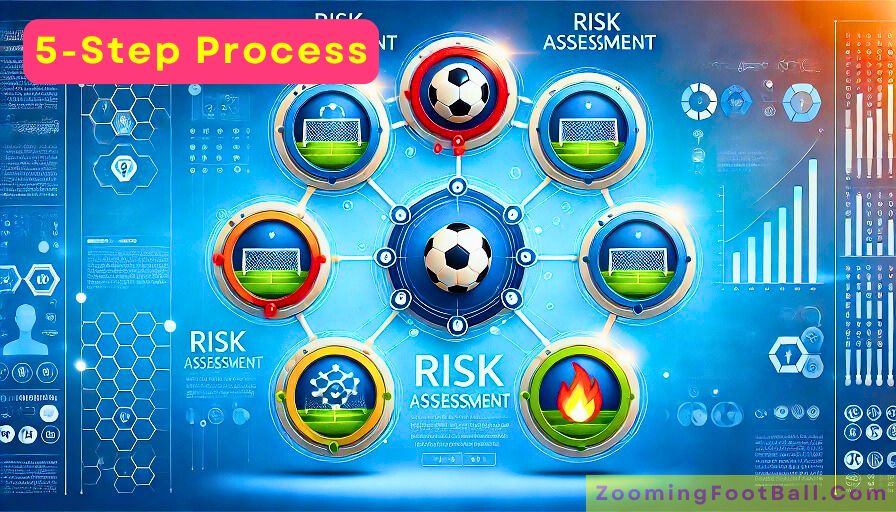
The 5-Step Process for Conducting a Risk Assessment in Soccer
Conducting a risk assessment in Soccer is a systematic process that ensures the safety of everyone involved, from players and coaches to spectators and staff. By following these five steps, you can identify potential hazards, evaluate their risks, and implement effective control measures. This process not only prevents injuries but also ensures compliance with legal requirements and promotes a culture of safety within the club.

Step 1: Identify the Hazards
The first step in a risk assessment is to identify potential hazards that could cause harm. These can vary depending on the environment, but common hazards in Soccer include:
1. Field Conditions
The Soccer pitch is where most risks arise. Uneven surfaces, potholes, or slippery grass can lead to trips, falls, or even serious injuries. For example, a player running at full speed might twist an ankle if the pitch is uneven. Regular inspections before training sessions or matches can help identify and address these issues.
2. Equipment Safety
Faulty or poorly maintained equipment is another major hazard. Unstable goalposts, damaged training cones, or worn-out protective gear can pose significant risks. For instance, an unsecured goalpost could topple during a game, causing severe harm to players or spectators.
3. Environmental Factors
External conditions like extreme weather (heavy rain, snow, or heat) and poor lighting can also create hazards. Playing in extreme heat without proper hydration measures can lead to heatstroke, while poor lighting increases the risk of collisions or missteps.

Step 2: Determine Who Could Be Affected and How
Once you identify hazards, determine who could be affected and how. This includes:
1. Players
Players are the most directly affected by hazards on the pitch. Unsafe field conditions or faulty equipment can lead to sprains, fractures, or more serious injuries. For example, a slippery pitch might cause a player to fall during a tackle, resulting in a head injury.
2. Coaches and Referees
Coaches and referees are also at risk, especially if they are on the pitch during training sessions or matches. They might face the same hazards as players, such as uneven surfaces or extreme weather conditions.
3. Spectators
Spectators can be affected by hazards like overcrowded stands, unsafe seating, or poorly marked emergency exits. For instance, a sudden stampede due to inadequate crowd control could lead to serious accidents.
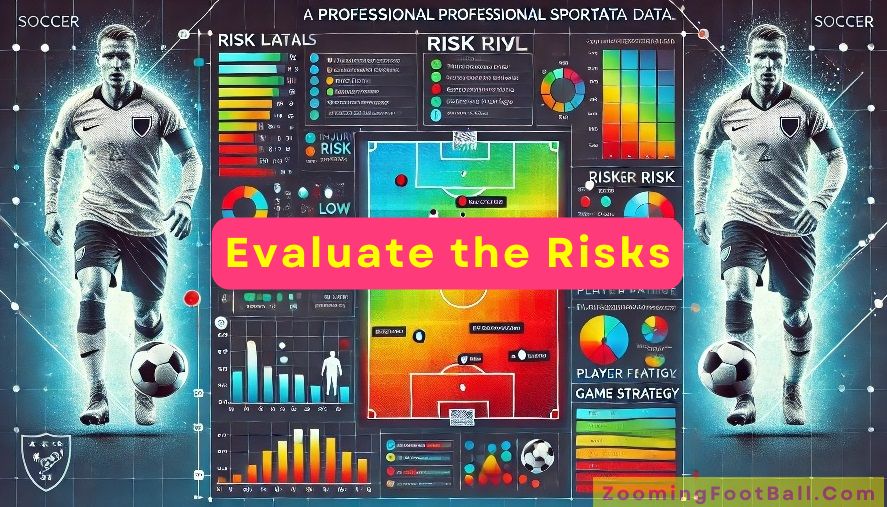
Step 3: Evaluate the Risks and Determine Severity
After identifying hazards and those affected, the next step is to evaluate the risks. This involves assessing the likelihood of an incident occurring and the potential impact if it does.
1. Using a Risk Matrix
A risk matrix is a useful tool for evaluating risks. It categorizes risks based on their likelihood (low, medium, high) and impact (minor, moderate, severe). For example:
| Likelihood/Impact | Minor | Moderate | Severe |
| High | Medium Risk | High Risk | Critical Risk |
| Medium | Low Risk | Medium Risk | High Risk |
| Low | Low Risk | Low Risk | Medium Risk |
2. Assigning Risk Categories
Based on the matrix, risks can be categorized as:
- Low Risk: Minimal impact, unlikely to occur.
- Medium Risk: Moderate impact, possible occurrence.
- High Risk: Significant impact, likely to occur.
- Critical Risk: Severe impact, very likely to occur.
For example, a slippery pitch during heavy rain might be classified as a high risk due to the high likelihood of falls and the potential for serious injuries.
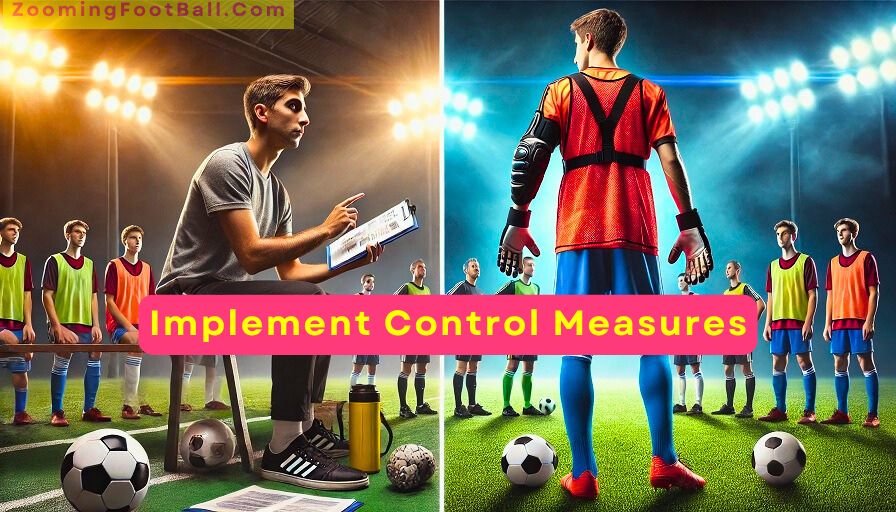
Step 4: Implement Control Measures
Once risks are evaluated, the next step is to implement control measures to reduce or eliminate them.
1. Regular Pitch Inspections
Conducting regular inspections of the Soccer pitch before games or training sessions can help identify and address hazards like potholes or uneven surfaces.
2. Safety Training for Staff
Mandatory safety training for coaches, referees, and staff ensures everyone knows how to handle emergencies and prevent accidents.
3. Proper Protective Gear
Ensuring players wear appropriate protective gear, such as shin guards or head protection for goalkeepers, can significantly reduce the risk of injuries.
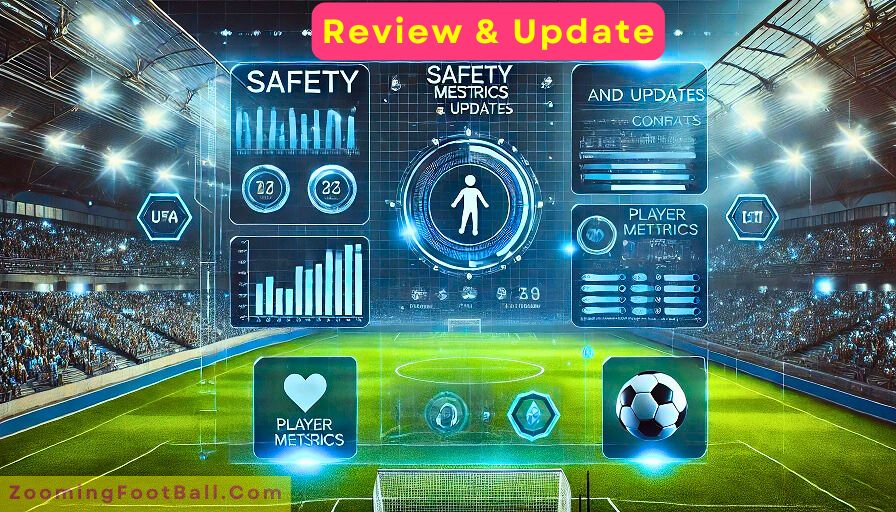
Step 5: Review and Update the Soccer Risk Assessment
The final step is to regularly review and update the risk assessment to ensure it remains effective.
1. Periodic Safety Audits
Schedule regular safety audits to identify new hazards or changes in existing risks. For example, a newly installed floodlight system might require additional safety checks.
2. Updating Procedures
Update risk assessment procedures after incidents or changes in regulations. For instance, if a new law mandates stricter safety measures for goalposts, the club must revise its procedures accordingly.
Graphical Chart: The 5-Step Risk Assessment Process
| Step | Action | Example |
| 1 | Identify Hazards | Uneven pitch, faulty goalposts, extreme weather. |
| 2 | Determine Who Could Be Affected | Players, coaches, spectators. |
| 3 | Evaluate Risks Using a Risk Matrix | Slippery pitch = High Risk. |
| 4 | Implement Control Measures | Regular pitch inspections, safety training, protective gear. |
| 5 | Review and Update the Risk Assessment | Conduct safety audits, update procedures after incidents. |
By following this 5-step process, Soccer clubs can create a safer environment for everyone involved. Whether it’s ensuring the Soccer pitch is in top condition or providing protective gear for players, each step plays a crucial role in injury prevention and safety management.

Key Areas to Focus on in Soccer Risk Assessment
When conducting a risk assessment in Soccer, it’s essential to focus on specific areas where hazards are most likely to occur. These areas include the Soccer pitch, clubhouse, match day setups, and sports facilities.
By addressing these key areas, Soccer clubs can ensure the safety of players, coaches, spectators, and staff. Let’s dive deeper into each of these areas and explore the steps needed to minimize risks.
Safety on the Pitch
The Soccer pitch is the heart of the game, but it’s also where many hazards can arise. Ensuring safety on the pitch involves addressing both environmental and structural risks.
1. Secure Goalposts and Inspect Turf Conditions
Unstable goalposts are one of the most dangerous hazards on the pitch. A poorly anchored goalpost can topple during a game, causing serious injuries to players or spectators. Conduct regular inspections to ensure goalposts are securely fixed and meet safety standards.
The condition of the turf is equally important. Uneven surfaces, potholes, or slippery grass can lead to trips, falls, and injuries. For example, a player sprinting down the field might twist an ankle if the pitch is uneven. Regular maintenance, such as leveling the turf and filling in holes, can prevent such accidents.
2. Ensure Proper Hydration Stations and Emergency Exits
Dehydration is a common risk during training sessions or matches, especially in hot weather. Providing accessible hydration stations ensures that players can stay hydrated and avoid heat-related illnesses like heatstroke.
Emergency exits must also be clearly marked and easily accessible. In case of an incident, such as a fire or severe injury, quick evacuation is crucial. For example, having multiple exit points around the pitch can help spectators and staff evacuate safely during an emergency.

Safety in the Clubhouse and Surrounding Areas
The clubhouse and surrounding areas are often overlooked in risk assessments, but they are just as important as the pitch. These areas include locker rooms, offices, and spectator facilities.
1. Fire Exits, Electrical Wiring, and Locker Room Hazards
Fire safety is a top priority in the clubhouse. Ensure that fire exits are clearly marked, unobstructed, and regularly inspected. Faulty electrical wiring or overloaded sockets can also pose fire hazards, so regular checks by a qualified electrician are essential.
Locker rooms can be hotspots for accidents, such as slips on wet floors or injuries from improperly stored equipment. Installing non-slip mats and ensuring equipment is stored securely can reduce these risks.
2. First Aid Availability and Defibrillator Locations
Accidents can happen at any time, so having first aid kits and defibrillators readily available is crucial. Place these in easily accessible locations, such as near the pitch or in the clubhouse. Train staff in basic first aid and CPR to handle emergencies effectively.
Match Day Safety for Players and Spectators
Match days bring unique challenges due to the large number of people involved. Ensuring safety for both players and spectators requires careful planning and coordination.
1. Proper Emergency Evacuation Plans
In case of an emergency, such as a fire or severe weather, having a clear evacuation plan is essential. This includes identifying safe assembly points and ensuring all staff know their roles during an evacuation. For example, staff must guide spectators to exits in an orderly manner to prevent panic and overcrowding.
2. Managing Crowd Control and Ticketing Areas
Crowd control is critical to prevent accidents like stampedes or overcrowding. Barriers, signage, and trained security personnel can help manage the flow of people. Event organizers must design ticketing areas to prevent long queues and bottlenecks, reducing frustration and ensuring safe conditions.
Risk Assessment for Soccer Facilities and Halls
Indoor sports facilities and halls are used for training sessions, meetings, and events. These areas require special attention to ensure they are safe for use.
1. Indoor and Synthetic Turf Maintenance
Indoor facilities often use synthetic turf, which can wear out over time and become a hazard. Regular inspections and maintenance, such as replacing worn-out turf or fixing uneven surfaces, are essential.
Lighting is another critical factor. Poor lighting can lead to trips and falls, especially during fast-paced drills. Facility managers must ensure that all areas are well-lit and regularly check light fixtures for maintenance.
2. Storage of Hazardous Materials Like Cleaning Chemicals
Store cleaning chemicals and other hazardous materials securely in designated areas. Improper storage can lead to spills, fires, or exposure to harmful substances. For example, cleaning chemicals should be kept in locked cabinets away from players and spectators.
Graphical Chart: Key Areas for Soccer Risk Assessment
| Area | Key Hazards | Control Measures |
| Safety on the Pitch | Unstable goalposts, uneven turf, dehydration. | Regular inspections, hydration stations, emergency exits. |
| Clubhouse and Surroundings | Fire hazards, electrical issues, locker room accidents. | Fire exit checks, non-slip mats, first aid availability. |
| Match Day Safety | Crowd control, emergency evacuations, ticketing bottlenecks. | Clear evacuation plans, barriers, trained security staff. |
| Sports Facilities and Halls | Worn-out turf, poor lighting, hazardous materials. | Regular maintenance, proper lighting, secure storage of chemicals. |
By focusing on these key areas, Soccer clubs can create a safer environment for everyone involved. Whether it’s ensuring the pitch is in top condition or managing crowd control on match days, each step plays a crucial role in injury prevention and safety management.
Examples of Soccer Risk Assessment
To better understand how risk assessments work in practice, let’s explore three real-world examples. These examples cover Soccer training sessions, match days, and youth Soccer coaching. Each scenario highlights specific hazards and the steps needed to ensure safety for everyone involved.
Example 1: Risk Assessment for a Soccer Training Session
Players develop their skills during a training session, but hazards can arise if they don’t take proper precautions. Here’s how to conduct a risk assessment for a typical training session.
Checklist for Safe Drills, Warm-Ups, and Hydration Breaks
- Inspect the Pitch: Before starting, check the Soccer pitch for hazards like uneven surfaces, potholes, or debris. Ensure goalposts are securely anchored.
- Warm-Up Routines: Begin every session with a proper warm-up to prevent muscle strains and injuries. Include dynamic stretches and light jogging.
- Safe Drills: Design drills that minimize the risk of collisions or overexertion. For example, avoid overcrowding during passing drills and ensure players maintain a safe distance.
- Hydration Breaks: Schedule regular breaks for hydration, especially in hot weather. Provide water stations and encourage players to drink frequently.
- First Aid Readiness: Have a first aid kit on hand and ensure at least one staff member is trained in basic first aid and CPR.
By following this checklist, coaches can create a safe and productive environment for training sessions.
Example 2: Soccer Risk Assessment for a Match Day
Match days are exciting but come with unique challenges due to the large number of players, coaches, and spectators. Here’s how to conduct a risk assessment for a match day:
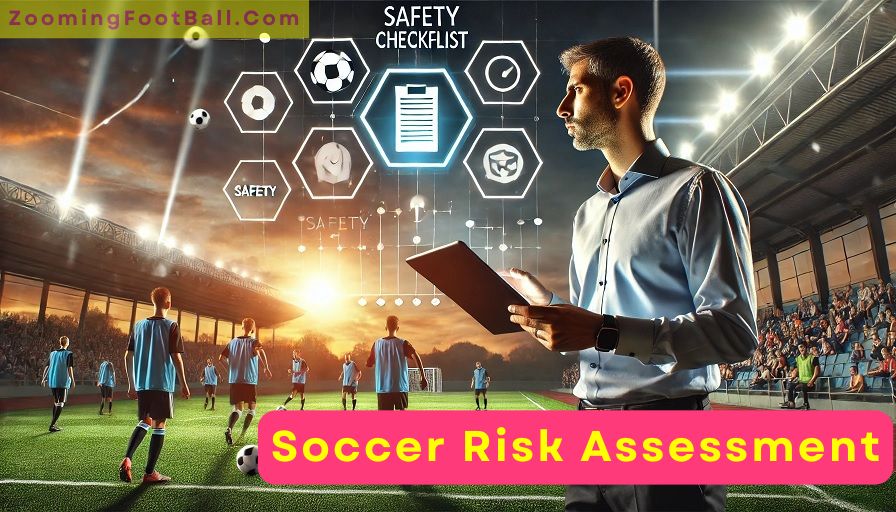
Crowd Movement, Emergency Response, and Weather Contingencies
- Crowd Control: Plan for the safe movement of spectators by setting up barriers, signage, and designated entry/exit points. Ensure security personnel are present to manage crowds.
- Emergency Response: Develop a clear emergency evacuation plan. Identify safe assembly points and ensure all staff know their roles during an evacuation.
- Weather Contingencies: Monitor weather conditions and have a plan in place for extreme weather. For example, postpone the match if there’s a risk of lightning or heavy rain.
- Medical Preparedness: Ensure medical staff are on standby and that defibrillators are easily accessible. Provide first aid stations around the venue.
- Communication: Use loudspeakers or digital displays to communicate important information, such as emergency procedures or weather updates.
By addressing these areas, Soccer clubs can ensure a safe and enjoyable experience for everyone on match day.
Example 3: Risk Assessment for Youth Soccer Coaching
Youth Soccer coaching requires special attention due to the age and vulnerability of the players. Here’s how to conduct a risk assessment for youth Soccer:
Child-Specific Hazards, Supervision Needs, and Injury Prevention
- Child-Specific Hazards: Identify risks that are unique to children, such as overexertion, improper use of equipment, or lack of awareness of safety rules. For example, ensure players use age-appropriate protective gear like shin guards and smaller goalposts.
- Supervision Needs: Ensure there’s adequate supervision at all times. The recommended ratio is one coach for every 10-12 children. This helps prevent accidents and ensures players follow safety guidelines. You may like this: Mini Soccer Rules: Complete Guide for Players, Coaches, and Parents
- Injury Prevention: Focus on teaching proper techniques to avoid injuries. For example, demonstrate how to tackle safely or how to fall without getting hurt.
- Hydration and Breaks: Children are more susceptible to dehydration and fatigue, so schedule frequent hydration breaks and rest periods.
- Parental Involvement: Communicate with parents about safety measures and encourage them to reinforce safety rules at home.
By tailoring the risk assessment to the needs of young players, coaches can create a safe and nurturing environment for youth Soccer.
Graphical Chart: Examples of Soccer Risk Assessment
| Example | Key Hazards | Control Measures |
| Training Session | Uneven pitch, collisions, dehydration. | Pitch inspection, safe drills, hydration breaks, first aid readiness. |
| Match Day | Crowd control, emergencies, extreme weather. | Barriers, evacuation plans, medical preparedness, weather monitoring. |
| Youth Soccer Coaching | Overexertion, improper equipment use, lack of supervision. | Age-appropriate gear, supervision, injury prevention techniques, hydration breaks. |
These examples demonstrate how risk assessments can be tailored to different scenarios in Soccer. Whether it’s a training session, a match day, or youth Soccer coaching, the goal is always the same: to create a safe environment where everyone can enjoy the game. By identifying hazards, implementing control measures, and regularly reviewing the process, Soccer clubs can ensure the safety and well-being of all involved.
FAQs About Risk Assessment in Soccer
What are the 5 Key Elements of a Risk Assessment?
The five elements are hazard identification, risk evaluation, control measures, documentation, and regular review.
How Often Should Risk Assessments Be Reviewed?
Assessments should be reviewed at least annually or whenever there’s a significant change, like new equipment or facilities.
What Are Common Risks in Soccer Coaching?
Common risks include player injuries, equipment failures, and environmental hazards like extreme weather conditions.
How Can Technology Help with Risk Assessments?
Apps and software can streamline the process, from hazard tracking to generating reports. For example, digital checklists ensure nothing is overlooked.
Tips for Effective Risk Management in Soccer
Documenting Your Risk Assessment Process
Keep detailed records of every assessment. This not only ensures compliance but also provides a reference for future reviews.
Training Staff and Coaches on Risk Management
Educate your team on identifying hazards and implementing safety measures. A well-trained staff is your first line of defense.
Using Templates and Tools to Simplify the Process
Leverage templates and digital tools to save time and ensure consistency. For example, a pre-filled checklist can make assessments quicker and more thorough.
Conclusion: Risk Assessment in Soccer
A comprehensive risk assessment isn’t just a formality—it’s a commitment to safety and excellence. By identifying hazards, evaluating risks, and implementing control measures, you can create a secure environment for players, coaches, and fans alike. Remember, safety is a team effort, and every step you take brings you closer to a safer, more enjoyable game.

Oliver Brown, a seasoned football blogger with a knack for insightful commentary, brings decades of passion and expertise to Zooming Football. Known for his sharp analysis and engaging storytelling, Oliver delves deep into the game’s nuances, offering readers a unique perspective on football’s most captivating stories and strategies.

